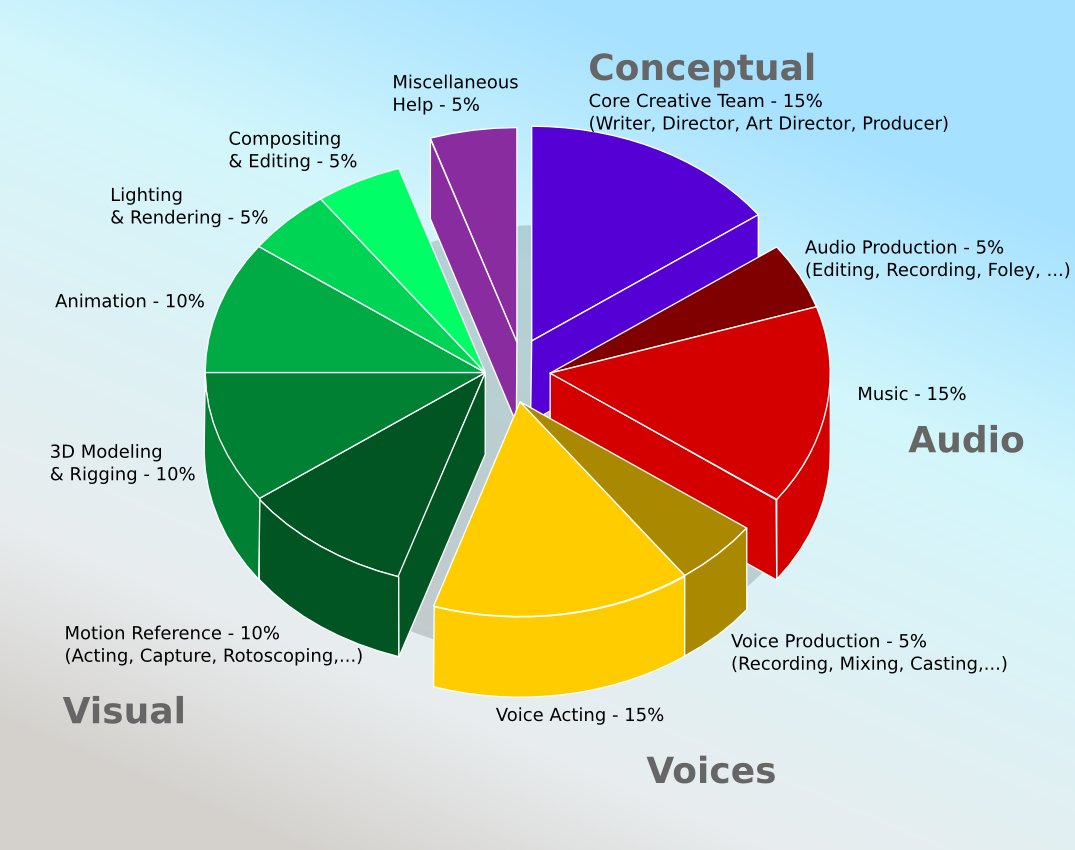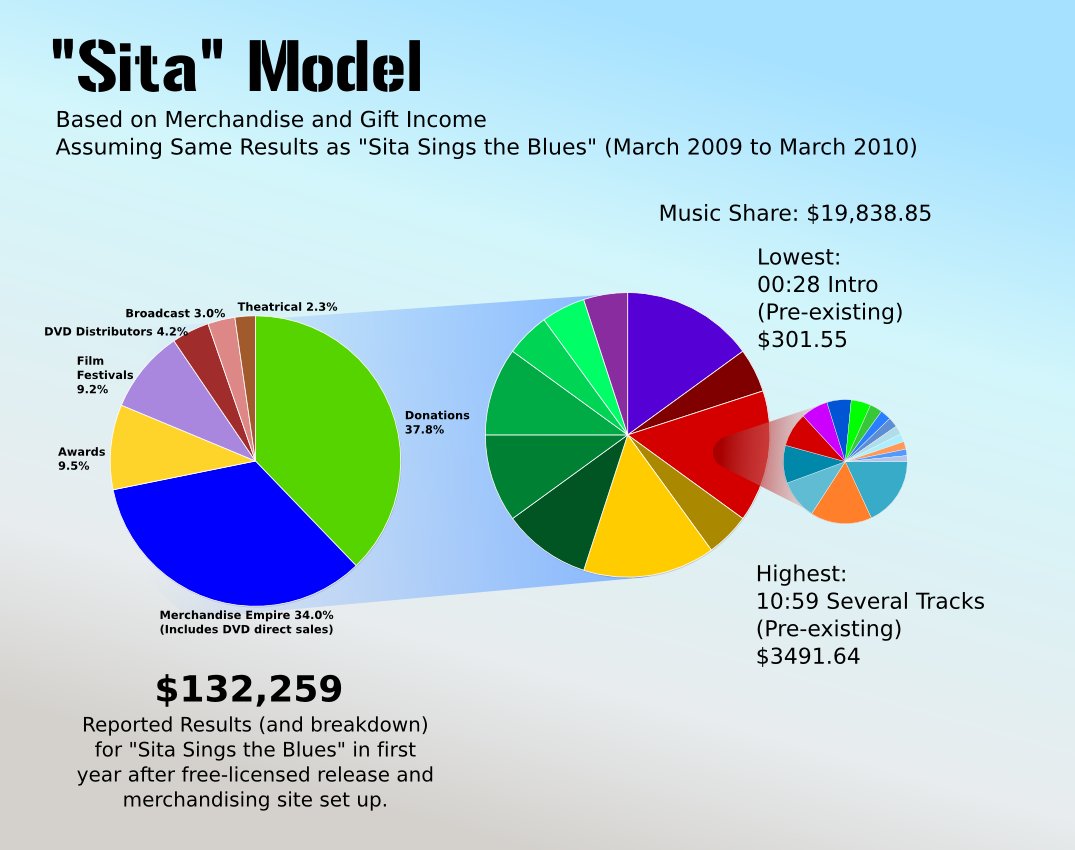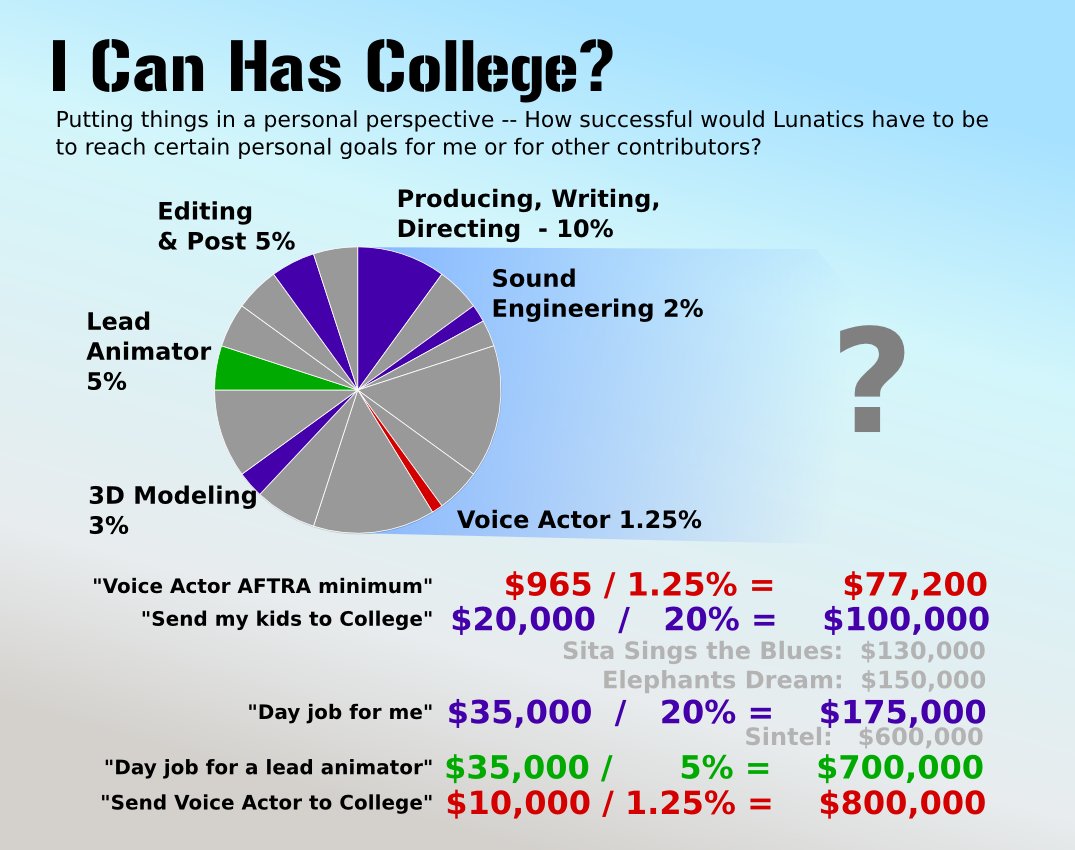Can artists actually make money on a free software driven free culture project? Having established the motivations and the basic principles in the first two parts, I'm going to look at the big picture here: how money would be distributed among major parts of the project (drawing partly on knowledge accumulated from the proprietary film and television industry -- taking into account the differences), where the money would come from, and what sort of income might be realistic based on the few projects that have gone before us.
Making Movies with Free Software
This article is part of an on-going series on the challenges I've faced in producing two free-licensed movies, Marya Morevna, through the Morevna Project and Lunatics, which we are working on as Anansi Spaceworks.

Balancing different types of work
Of course, in the musical soundtrack example from Part 2, the top of the evaluation (the whole "pie") is not the total revenue or even the total profits. It's the music share of the project -- the fraction of the profits that are spent on music. That is, in itself, only a portion of the audio share which will include mixing, sound effects, foley artist, and possibly even the voice actors, depending on how the project is subdivided).
Drawing on traditions from the proprietary film industry provides a simple way of appealing to the expectations of contributors
Other departments, such as animation or voice acting, will need totally different schemes, reflecting the realities of workflow and relative contributions. However, drawing on traditions from the proprietary film industry provides a simple way of appealing to the expectations of contributors.
Standard Scales
The music example I set out in part 2 was particularly straightforward, although it should be noted that I drew on some research to create it: I looked at the Jamendo Pro licensing contracts to see what kind of fees were expected in various proprietary scenarios. They didn't match our model, and so we won't be using Jamendo Pro, but they do tell us a lot about artists' expectations: how much they expect to make and how they expect the relative value of their work to be weighed.
Similar homework will be required to appropriately gauge effort in other departments: I can look up industry information sources on budgeting film projects. For example, with acting, we can look up the standard contracts and minimum payments for actors doing comparable work. These are generally published online by acting unions. Other tables exist for budgeting animation.
The actual rates these schedules quote are not directly comparable for a free project... but what we certainly can use these documents for is to estimate the relative value
The actual rates these schedules quote are not directly comparable for a free project. They make too many assumptions about the total budgets of films, because they assume that a proprietary "gambler" model applies. In that model, the money available has a real cash value, and is acquired by getting investors to assume the total risk in advance of production.
In a free culture project, since what people are mainly risking is time, and on a project they enjoy working on, the assumptions must be different.
But what we certainly can use these documents for is to estimate the relative value of contributions on different elements of production. These can then be added up and divided by the total, as shown earlier for music.
The view from the top
Even worse, though, is the problem of effectively evaluating these costs against each other. How do you decide what fraction of the production should go into audio versus video?
To untangle all of this, it's constructive to look at how proprietary projects work. After all, these problems are not unique to free culture projects, and the proprietary industry has been dealing with them for decades. The difference is that they have experience.
At the top level, a budgeting decision will have to be made by the producer on how much to "spend" on each component of the project
At the top level, a budgeting decision will have to be made by the producer on how much to "spend" on each component of the project. It's important to realize that this is a creative, subjective decision. There's no hard-and-fast rule for how the various resources in a production should be balanced. Rather, you have to consider what sort of production you want to create, and how much effort each piece of that production should represent.

This is really not that different from budgeting with a proprietary project except that the money is all (or at least mostly) in potentials, rather than actual cash. But the concept is basically the same -- we will probably, for example, spend 20% on the music budget examined in part 2. Another 15% will go to the core creative team (writer, director, producer, art director). Then 20% will go to recording the voices and visual recordings of their performances. And 40% will go to the 3D animation (modeling, rendering, motion capture or video reference, animation, lighting, rendering, compositing, editing, and so on). Another 5% is left over for miscellaneous contributions, to give some wiggle room later on the process. Figure 2 shows a current, albeit probably not final, version of this profit-sharing pie for the Lunatics pilot, "No Children In Space".
It's important to make this pie in advance, and publish it along with the project materials at the beginning, before significant contributions are made. That way, people have a realistic idea of what they can expect
It's important to make this pie in advance, and publish it along with the project materials at the beginning, before significant contributions are made. That way, people have a realistic idea of what they can expect. If they feel undervalued, they can decide not to contribute, or they can decide to contribute less. On the other hand, clear evidence of a plan to pay them something may motivate a lot of people who'd otherwise steer clear of the project entirely.
One conspicuous thing missing from this pie is advertising or promotion -- proprietary films usually spend a lot on that. However, this is one of the big wins from a free-licensed release. We have a reasonable expectation that the film can be distributed on YouTube or other video sharing outlets and largely advertise itself. There will also be some small amount of promotion inherent in making products available online, but this is part of the overhead costs of merchandising, rather than part of the production process.
There is also some question as to whether any money should go to the free software projects used in the production. I'm not really sure about that, although I can certainly imagine scenarios that include this.
Lowering "The Line"
In proprietary film production, there is a concept, usually known as "The Line". People are employed on a film either "Below the Line" or "Above the Line." The people you see in the main title credits are usually "above the line": producer, writer, director, principle actors, and so on. Most of the huge number of people in the end credits, on the other hand, are usually "Below the Line" (although some aren't even credited).
This slightly feudal system exists to separate the aristocrats with a stake in the production from the serfs who just want to get their porridge and go home at the end of the day.
This slightly feudal system exists to separate the aristocrats with a stake in the production from the serfs who just want to get their porridge and go home at the end of the day
The folks above the line expect to get prominent credit for the production, a chunk of the profits, and thereby build their career. They are betting their reputations on the quality of the final film, and (it is believed) they are primarily responsible for that quality. Their performance is highly subjective, and so we are simply trusting them to do their best. If the overall quality is good, the film makes a large profit, and they make money from it. If it's poor, they'll get whatever the minimum is that they were contracted for.
Below the line, on the other hand, the only requirement is a certain base level of professionalism, and the reward is fixed. They have little stake in the quality of the production and they can't really control it in any case. Generally speaking they just expect to get paid (up front) for what they do.
For free culture projects, with no budget to speak of, it's clearly the goal to treat everyone on the production as "above the line" contributors. Essentially the only "below the line" contributions, then, will be contracted services -- things no one directly involved with the project has the equipment or skills to do, and so they have to be purchased as services. Some examples:
- Render farm computer hardware (bought or rented time)
- DVD production (assuming it gets that far)
- Sound studio rental (or sound equipment)
- Cameras, recorders, microphones, etc.
- Art or music commissions
- Accounting
Again, different productions might make different choices. Many people might contract out sound engineering tasks, DVD mastering, or cover art design for example (but those happen to be things I can do myself). Others might omit commissions for art or music, relying entirely on volunteers for those things (I think commissions are in order because these people must contribute at an early stage, when the risk is too high, whereas people involved in actual production tasks have a much more clear-cut idea of where the production is going and have more control over its success).
How much money are we talking about?
It's instructive, I think, to do a little math with the schemes described above, based on different assumptions about the business model and sales success. This is a standard part of any good business plan, and there's no reason we should be any different if we are asking people to invest in the project (either financially or by contributing effort). Also, for those who have difficulty with the abstractions of percentages and pie-charts, computing some actual dollars-and-cents "what if" scenarios is much more compelling.

Figure 3 is a very conservative revenue model. It assumes that all income comes from selling DVDs (from a pre-sale campaign, as with the Blender movies, or from Creator Endorsed sales later on). Of course, this is probably not the way things would work. A lot of the revenue would likely come from ancillary sales and even voluntary contributions, as has been the case with "Sita Sings the Blues".
Fortunately, Nina Paley has published her actual revenue and profit numbers for Sita
Fortunately, Nina Paley has published her actual revenue and profit numbers for Sita, so I can propose another estimate, which is simply to assume that our numbers will be the same as her numbers were in the first year. This model is shown in Figure 4. Again, I've calculated the resulting payouts to the lowest and highest paid musical artists through the music budget, as examples. You'll note that this is considerably more money and that most of the sales don't come from direct DVD sales (although some are folded into the "Merchandise Empire" figure).

Another way to look at the money is to ask "How profitable would Lunatics have to be in order to meet certain personal goals?" For example, an oft-raised objection to free culture is the desire of older artists to "be able to put their kids through college." It also happens to be a real goal of mine, so I looked up the tuition rates for my local state university and alma mater (which is the University of Texas), multiplied by two (for the peak outlay when two of my kids are in college at the same time). This comes out a little less than $10,000 per semester or $20,000 per year (yes, I know, this doesn't include room and board, but I figure I'll be paying that anyway, so just paying the tuition bills would be nice).
My share of the artists' profits pie is probably going to be about 20%, due to the various hats I'm likely to be wearing on this project (I expect I'll be doing a lot of it myself). I've included my wife's fraction, too, since they're her kids too. So, the total profits would have to be $20,000 divided by 20% or $100,000. Considering the profits of "Sita Sings the Blues" and the budget for "Elephants Dream", this does not seem unreasonable at all.
Another way to look at the money is to ask "How profitable would Lunatics have to be in order to meet certain personal goals?"
Increasing the goal to $35,000 per year makes it pay (me) enough to justify considering it a "day job" (fortunately, the place I live has a fairly low cost of living). This pushes the project goal to $175,000. That's a little more than Sita made, but it's not inconceivable, and it's quite a bit less than the budget that was raised to make the latest Blender movie, Sintel.

So that's me taken care of, but what about some of the other people on the project? For example, let's consider the cast. I estimate that a single voice actor playing a lead role in the series will get about 1.25% of the overall profits. Typically this will be a single-day session per episode, although there might need to be a day scheduled for pick-ups. Actors lend very important qualities of personality to an animated production, but their involvement is relatively brief compared to all the people who work behind the scenes.
As "new media" we're exempt from union minimum payment rules, but I want to compare to more conventional media. For a animated conventional TV show of more than 10 minutes length, the 2010 AFTRA minimum rate is $837.00. There's also some overheads, such as health insurance that have to be paid, so the total is really about $965. It'd be nice to think that we could do at least that well, so how much is that? Well, it turns out to be about $77,200 -- well under the other estimates I've made here.
Based on previous productions it seems clear that artists _can_ get paid on our production -- _if_ we can meet our artistic goals
A lead animator will probably make about 5% (half the animation budget -- here, I'm using "animation" in the strict sense, as opposed to modeling, rigging, rendering, and other parts of the 3D animation task). This assumes a fairly small team, but I think that's a realistic assumption. Assuming $35,000 is also a reasonable annual income for them, they'd need the production to make about $700,000 per year. Similarly, allowing a lead actor to send themselves to a public college for a year on their one or two days' work on Lunatics would make the target $800,000. These targets are a little bit high -- it means we'd have to do better than any previous free culture video project. But that's not inconceivable in a new and growing field.
Overall, I find these estimates very promising. Based on previous productions it seems clear that artists can get paid on our production -- if we can meet our artistic goals. If we hit the right market, we even have a reasonable hope of doing quite well.
References
[1] The music breakdown is explained in the previous column, 'Artists should be paid, Part 2: What's "fair"?'
2(http://questioncopyright.org/sita-distribtion-numbers)
3(http://www.utexas.edu/tuition/costs.html) from The University of Texas
[4] Budget figure from 'Elephants Dream' Wikipedia entry. I also fact-checked this directly with Ton Roosendaal when it came out
5(http://en.wikipedia.org/wiki/Sintel) Wikipedia entry budget (also available from Blender Foundation)
Licensing Notice
This work may be distributed under the terms of the Creative Commons Attribution-ShareAlike License, version 3.0, with attribution to "Terry Hancock, first published in Free Software Magazine". Illustrations and modifications to illustrations are under the same license and attribution, except as noted in their captions (all images in this article are CC By-SA 3.0 compatible).